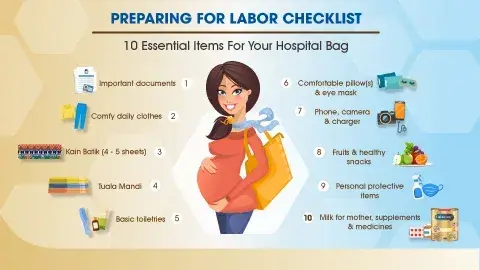Preparing for Delivery


The big day is full of surprises. Here’s how to prepare for delivery, based on what moms who’ve been there say they wish they had known beforehand.
No matter how well you plan it, your labor and delivery will likely throw up a few surprises. You would be in a better position to deal with those surprises if you were well-informed and well-prepared. There are many moms who just weren’t prepared for the reality of labor. Here is what they wish they had known before labor and delivery.
Preparing for delivery to deliver my baby: The start of labor isn’t the same for every woman.
On TV, it looks so easy—there’s a gush of water, a frantic drive to the hospital, a few pushes, and your little one is here. Part of learning how to prepare for delivery is separating the fact from fiction and realizing that it's not always like it is on TV. In reality, it can be a bit trickier. In fact, for some women, it’s hard to tell false labor from the real deal.
Water breaking
For some women, their water breaking is the first sign that the birthing process has begun. It can be a gush of water, like on TV, but for other women, however, it’s a trickle. In some cases, it can be hard to tell the difference between amniotic fluid and urine. Your best bet? Call your doctor. Tell her you’re unsure if your water just broke but describe any odor or the color of the liquid. She’ll probably have you come in for an exam. On the other hand, your water may not break until a health-care provider helps it along at the hospital.
Contractions
Telling the difference between Braxton-Hicks and true labor contractions can be confusing. Generally, true contractions have a regular pattern and last for 30 to 70 seconds.i But your doctor is only a phone call away if you need to consult.
Preparing for delivery to deliver my baby: Labor is a journey.
The first stage of labor—when you’re dealing with contractions but not ready to push—the average length can last from hours to days.ii Remember, it may be a slow process, but there are things you can do to make it easier:
1. Take a bath (with your doctor’s OK, if your water broke) or a shower.
2. Go for a walk
3. Change positions when you start to feel uncomfortable.
4. Try to breathe during contractions.
5. Have someone roll a tennis ball (with some pressure) on your lower back to relieve any pain.
6. Rock on a rocking chair or birthing ball.
7. Use music to help you relax.
Above all, remember that your little one isn’t on a schedule—sometimes slow and steady is best. As long as he is safe, your health-care team will let him call the shots.
Many hospitals may require that your pubic hair be shaved. Yes, many moms did not know that, and if they had, they would have prepared in advance, especially if they had a scheduled C-section.
You will sweat, scream and swear during labor. You will do all of that and will also most likely not remember any of it after the labor, but others in the room will remind you of it for years to come.
Your body will need a little time to bounce back
After labor, you might experience a few unexpected things:
1. Afterpains: You might have afterpains for a few days. It’s your uterus contracting. You may feel it most strongly when you’re nursing or if you’re taking medication to reduce bleeding. Don’t worry; it’s normal and should go away in a few days.
2. Heavy vaginal discharge: You’ll get what seems like a very heavy period after giving birth, and the blood may contain small clots. Contact your doctor, however, if you have a foul-smelling discharge, soak more than one sanitary pad in an hour, pass clots larger than a golf ball, or have a fever of 38 degrees Celsius or higher.
3. Hot and cold: Your body is adjusting to new blood and hormone levels; this can make you feel either sweaty or chilled.
4. Leakage: It’s not uncommon for some urinary incontinence to occur, especially after a prolonged labor. It might happen when you sneeze, cough, or laugh. Ask your doctor when you should start your kegel exercises.
5. Weight: You might be surprised that you don’t lose all the growing baby weight after having your little one. You’ll probably lose about 5.9 kg (which includes the weight of the growing baby, amniotic fluid, and placenta). Over the next week or so, you’ll lose water weight too.
6. Swelling of legs: Legs usually swell up after delivery. Normally, the swelling disappears within two weeks due to the redistribution of excess fluid retention in pregnancy. The kidneys excrete it through urination.iii
But once all the work is done, the best surprise may be how perfect your little one is to you.
References:
iSigns of labor: Know what to expect. (2016, June 18). Retrieved June 01, 2017, from http://www.mayoclinic.org/healthy-lifestyle/labor-and-delivery/in-depth…
iiStages of labor and birth: Baby, it's time! (2016, June 22). Retrieved June 01, 2017, from http://www.mayoclinic.org/healthy-lifestyle/labor-and-delivery/in-depth…
iiiProblems in the week after the birth. Retrieved on 16 June 2017 from, http://www.health.govt.nz/your-health/pregnancy-and-kids/birth-and-afte…







